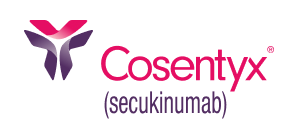
Start with skin
Complete clearance is achievable in PsO3,4
In MATURE, 55% of patients achieved PASI 100 with the UnoReady® Pen at Week 524
Observation of higher COSENTYX exposure was an exploratory end point
No clinical or statistical conclusions can be drawn
The 300-mg UnoReady Pen and the two 150-mg prefilled syringes demonstrated comparable safety profiles
Please see study designs at bottom of page.
Protect within
Proven to help stop the progression of irreversible joint damage in PsA3,5
At Year 2, 84% of patients† had no radiographic progression‡ on COSENTYX 300 mg (n=139)5
In FUTURE 5, mTSS was a prespecified exploratory end point at Year 2 in a subgroup of biologic-naive patients. No clinical or statistical conclusions can be drawn.5,6
Please see study designs at bottom of page.
Consider COSENTYX FIRST-LINE at the FIRST SIGN of moderate HS3
Disrupt the long-term impact of HS7,8
No head-to-head study in HS comparing COSENTYX vs another biologic has been conducted9
Flexible dosing means more options3
Please see study designs at bottom of page.
Trust in a well-studied clinical profile

NO Boxed WARNING3

NO warning for suicidal ideation and behavior3
COSENTYX HS and PsO trials did not screen out patients with depression or suicidal ideation10-15§

NO routine lab monitoring, including liver enzymes, during treatment3
Evaluate patients for TB prior to initiating treatment

NO trend toward increased AE incidence rates of Candida infections, IBD, MACE, or malignancy through Year 52

<1% of patients had immunogenicity over 5 years16
Neutralizing antibodies developed in 0.6% of patients with PsO and were not associated with loss of efficacy||
‡No radiographic progression was defined as a change from baseline in mTSS ≤0.0.5
§Protocol permitted investigator discretion to exclude any individuals with any medical or psychiatric condition that, in the investigator's opinion, would preclude the patient from adhering to the protocol or completing the study.10-15
||The detection of antibody formation is highly dependent on the sensitivity and specificity of the assay.3
Definitions
AE, adverse event; IBD, inflammatory bowel disease; MACE, major adverse cardiovascular event; mTSS, modified Total Sharp Score; PASI, Psoriasis Area and Severity Index; PsA, psoriatic arthritis; TB, tuberculosis.
References
1. Bagel J, Nia J, Hashim PW, et al. Secukinumab is superior to ustekinumab in clearing skin in patients with moderate to severe plaque psoriasis (16-week CLARITY results). Dermatol Ther (Heidelb). 2018;8(4):571-579.
2. Bissonnette R, Luger T, Thaçi D, et al. Secukinumab demonstrates high sustained efficacy and a favourable safety profile in patients with moderate-to-severe psoriasis through 5 years of treatment (SCULPTURE Extension Study). J Eur Acad Dermatol Venereol. 2018;32(9):1507-1514.
3. Cosentyx. Prescribing information. Novartis Pharmaceuticals Corp.
4. Sigurgeirsson B, Browning J, Tyring S, et al. Secukinumab demonstrates efficacy, safety, and tolerability upon administration by 2 ml autoinjector in adult patients with plaque psoriasis: 52-week results from MATURE, a randomized, placebo-controlled trial. Dermatol Ther. 2022;35(3):e15285. doi:10.1111/dth.15285
5. Data on file. CAIN457F2342 (FUTURE 5): 2-Year Interim Report. Novartis Pharmaceuticals Corp; May 2019.
6. Data on file. CAIN457F2342 (FUTURE 5): Clinical Study Report. Interim Analysis-Week 24. Novartis Pharmaceuticals Corp; November 2017.
7. van der Zee HH, Zouboulis CC, Reguiai Z, et al. The impact of lesion type on clinical response with secukinumab in patients with moderate to severe hidradenitis suppurativa: A post hoc analysis of the pooled data from SUNSHINE and SUNRISE phase 3 trials. Poster presented at: 33rd European Academy of Dermatology and Venereology (EADV) Congress; September 25-28, 2024; Amsterdam, The Netherlands. Poster P0186.
8. Data on file. Effect of secukinumab on draining tunnels in patients with moderate to severe hidradenitis suppurativa: post hoc analysis of the SUNSHINE and SUNRISE phase 3 randomised trials. Novartis Pharmaceuticals Corp; February 2023.
9. Clinicaltrials.gov. Search criteria. Accessed April 10, 2025. https://clinicaltrials.gov/search?cond=Hidradenitis%20Suppurativa&intr=Secukinumab%20300%20MG&outc=head%20to%20head
10. Blauvelt A, Prinz JC, Gottlieb AB, et al; for the FEATURE Study Group. Secukinumab administration by pre-filled syringe: efficacy, safety, and usability results from a randomized controlled trial in psoriasis (FEATURE). Br J Dermatol. 2015;172(2)(suppl):1-20.
11. Data on file. AIN457A2302 (ERASURE): Clinical Trial Protocol. Novartis Pharmaceuticals Corp; February 2011.
12. Data on file. AIN457A2303 (FIXTURE): Clinical Trial Protocol. Novartis Pharmaceuticals Corp; February 2011.
13. Data on file. CAIN457A2304 (SCULPTURE): Clinical Study Report. Novartis Pharmaceuticals Corp; September 2013.
14. Data on file. CAIN457A2309 (JUNCTURE): Clinical Study Report. Novartis Pharmaceuticals Corp; November 2014.
15. Kimball AB, Jemec GBE, Alavi A, et al. Secukinumab in moderate-to-severe hidradenitis suppurativa (SUNSHINE and SUNRISE): week 16 and week 52 results of two identical, multicentre, randomised, placebo-controlled, double-blind phase 3 trials. Lancet. 2023;401(10378):747-761 and Supplementary Appendices.
16. Reich K, Blauvelt A, Armstrong A, et al. Secukinumab, a fully human anti-interleukin-17A monoclonal antibody, exhibits low immunogenicity in psoriasis patients treated up to 5 years. J Eur Acad Dermatol Venereol. 2019;33(9):1733-1741.
